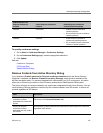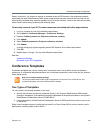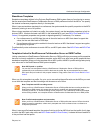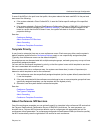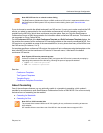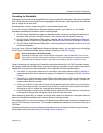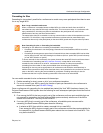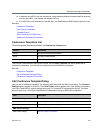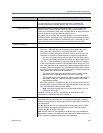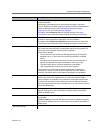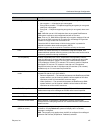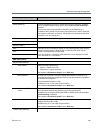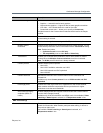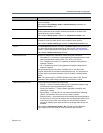
Conference Manager Configuration
Polycom, Inc. 193
Cascading for Size
Cascading for size makes it possible for a conference to contain many more participants than there is room
for on any single MCU.
You can enable cascade-for-size conferences with these steps:
1 Enable cascading for size in some or all of your conference templates.
2 For one or more of your MCUs, specify the number of ports per cascade-for-size conference to
reserve for cascade links (see Edit MCU Dialog).
Once a conference with cascading for size enabled has started (the “hub” MCU has been chosen), the
Polycom RealPresence DMA system does the following for each subsequent participant that dials into that
conference:
3 From among the MCUs that are currently part of the conference and have ports available that are
not reserved for cascading, the RealPresence DMA system randomly selects one of the MCUs
closest to the hub MCU. This may be the hub MCU.
4 If on every MCU that’s currently part of the conference, all available ports are reserved for
cascading, the RealPresence DMA system does the following:
a It selects an MCU from which to create a cascade link to a new MCU.
From among the MCUs that are currently part of the conference and that have ports available for
the cascade link, the RealPresence DMA system selects the one closest to the hub MCU. This
may be the hub MCU.
Note: Large cascaded conferences
When a conference is cascaded across multiple MCUs, the video and audio from each MCU is
transmitted to every other MCU through cascade links. This incurs some delay. In a conference with
many cascade links, this delay may become noticeable to the participants and could limit the
effectiveness of two-way real-time communication.
The transmission delay isn’t noticeable in one-way communication or when all the speakers are on the
same MCU. For this reason, large cascaded conferences are best suited to presentation-style
conferences where only a few participants (on the same MCU) speak and everyone else only listens.
Note Cascading for size vs. Cascading for bandwidth
Cascading for size differs from cascading for bandwidth in two primary ways:
• Cascading for size doesn’t use site topology information to choose additional MCUs to use for a
conference.
• Cascading for size supports a second level of cascade links so that a cascaded MCU can be either
one link away from the “hub” MCU hosting the conference (this is a “spoke” MCU) or two links away
(a “leaf” MCU linked to a “spoke”).
To host a cascade-for-size conference, the system chooses the same MCU that it would have chosen
in the absence of cascading (see MCU Selection Process), except that for each existing
cascade-for-size conference on an MCU, it subtracts the number of video ports reserved for
cascading from the number of video ports available when calculating port availability.
Cascading for size may not be appropriate for all conferences and should be used selectively. In
addition to the transmission delay issue described above, each cascade-for-size conference reserves
ports on the MCU, reducing the ports available for participants. Enabling cascading for size for
conferences that don’t require cascading causes MCU resources to be underutilized.



